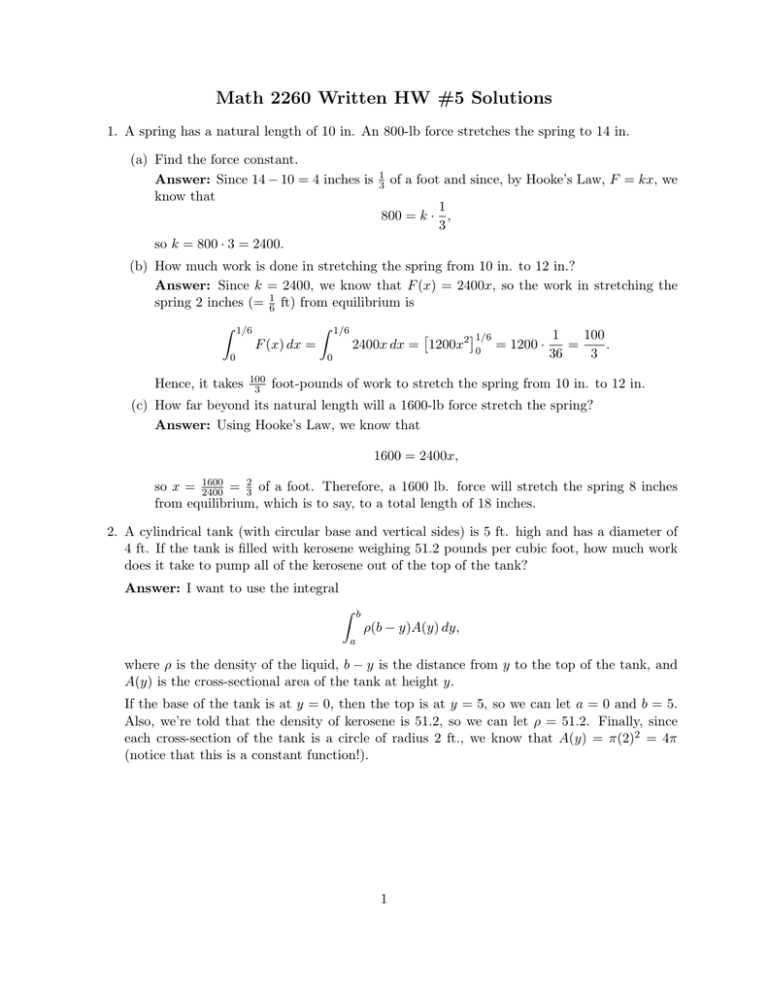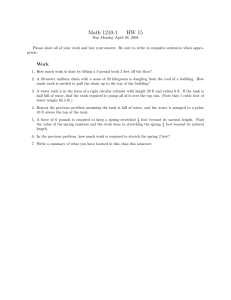Math 2260 Written HW #5 Solutions
advertisement

Math 2260 Written HW #5 Solutions 1. A spring has a natural length of 10 in. An 800-lb force stretches the spring to 14 in. (a) Find the force constant. Answer: Since 14 − 10 = 4 inches is know that 1 3 of a foot and since, by Hooke’s Law, F = kx, we 1 800 = k · , 3 so k = 800 · 3 = 2400. (b) How much work is done in stretching the spring from 10 in. to 12 in.? Answer: Since k = 2400, we know that F (x) = 2400x, so the work in stretching the spring 2 inches (= 61 ft) from equilibrium is Z 1/6 Z 1/6 1/6 1 100 2400x dx = 1200x2 0 = 1200 · = . 36 3 F (x) dx = 0 0 Hence, it takes 100 3 foot-pounds of work to stretch the spring from 10 in. to 12 in. (c) How far beyond its natural length will a 1600-lb force stretch the spring? Answer: Using Hooke’s Law, we know that 1600 = 2400x, 2 so x = 1600 2400 = 3 of a foot. Therefore, a 1600 lb. force will stretch the spring 8 inches from equilibrium, which is to say, to a total length of 18 inches. 2. A cylindrical tank (with circular base and vertical sides) is 5 ft. high and has a diameter of 4 ft. If the tank is filled with kerosene weighing 51.2 pounds per cubic foot, how much work does it take to pump all of the kerosene out of the top of the tank? Answer: I want to use the integral Z b ρ(b − y)A(y) dy, a where ρ is the density of the liquid, b − y is the distance from y to the top of the tank, and A(y) is the cross-sectional area of the tank at height y. If the base of the tank is at y = 0, then the top is at y = 5, so we can let a = 0 and b = 5. Also, we’re told that the density of kerosene is 51.2, so we can let ρ = 51.2. Finally, since each cross-section of the tank is a circle of radius 2 ft., we know that A(y) = π(2)2 = 4π (notice that this is a constant function!). 1 Therefore, the work to pump all of the kerosene out of the tank will be Z 5 Z 5 51.2(5 − y)(4π) dy = 204.8π (5 − y) dy 0 0 5 y2 = 204.8π 5y − 2 0 25 = 204.8π 25 − 2 25 = 204.8π · 2 = 2560π, or approximately 8042 foot-pounds of work. 3. Solve the differential equation xy + dy = 100x. dx Answer: First, I want to separate variables. To that end, subtract xy from both sides: dy = 100x − xy. dx Now, notice that we can factor x out of the right hand side: dy = x (100 − y) . dx Next, divide both sides by 100 − y and multiply both sides by dx to get dy = x dx. 100 − y Since the variables are now separated, we can integrate both sides Z Z dy = x dx 100 − y x2 − ln(100 − y) = +C 2 x2 ln (100 − y)−1 = + C. 2 Now solve for y by exponentiating both sides 2 (100 − y)−1 = ex /2+C 1 2 = eC ex /2 , 100 − y then multiplying both sides by 100−y 2 eC ex /2 1 = 100 − y, eC ex2 /2 2 and finally adding y − 1 2 eC ex /2 to both sides: 1 eC ex2 /2 2 y = 100 − e−C e−x /2 y = 100 − y = 100 − Ae−x for A = e−C a positive constant. 3 2 /2





